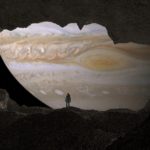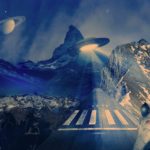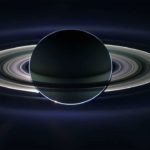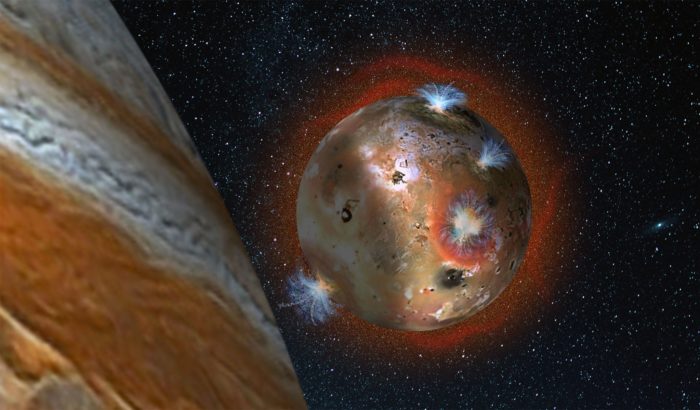
Space Exploration And The Moons Of The Gas Giants!
- By
- January 9, 2018
- September 29, 2021
- 12 min read
- Posted in
- Space, Our Solar System
While setting foot on another planet will undoubtedly be the greatest scientific achievement in the history of humanity, it is much more likely, and perhaps preferable, that the many moons (including our own) orbiting the planets of our solar system will be the first explored and perhaps even colonized. Indeed, these bases would be important launch points for travel much deeper into space. Essentially, conquering some of these cosmic satellites may prove to be critically important.

An image of one of the main moons of Jupiter
Of course, as we will look at shortly, it is on some of these moons, that we may find the conditions for life. Or maybe life, in one form or another, might already be present.
When pictures came hurtling back through the reaches of space of Charon, the largest moon to orbit the dwarf planet Pluto, courtesy of NASA’s New Horizons probe, there would be fierce debate as to whether there was “geological activity” [1] on the cosmic body. The detection of an atmosphere, albeit extremely thin, would also suggest such activity.
If there could be such activity that deep into the reaches of our solar system, might there be similar activity on the moons that are (relatively speaking) much further in, orbiting the gas giants such as Jupiter, Saturn, Uranus, and Neptune?
Each of these planets and their moons have had NASA probes perform flybys dating back to the 1970s. And with each mission, more information is revealed. As space exploration continues in the twenty-first century, more missions are planned. And exploring these moons might prove vital for reaching ever-further into the cosmos.
Check out the video below. It looks at some of the recent images of Charon asking whether we are “in the know” fully as to what they show.
Contents
Jupiter’s Intriguing Icy Worlds
Jupiter is the largest planet in our solar system and the largest of the four gas giants. It also has some of the most intriguing moons in its orbit.
Perhaps the moon of Jupiter that keeps drawing many scientists back is Europa, a satellite we have examined in-depth previously. So, while we will not spend time on Europa here, it is sufficient to say that many of those who study this moon believe there are genuine indicators of life existing in the ocean that resides below its icy surface. And there is nothing to suggest that this life will merely be microbial. Once further studies are complete concerning oxygen and hydrogen cycles of the ocean, it might be that substantially more advanced aquatic life is already present.
Jupiter has over 70 moons but, including Europa, four stand out from the others.
Europa aside, then, we will examine the remaining three main moons of Jupiter in a moment. First, though, check out the video below – a general overview of Jupiter’s moons.
Ganymede – The Largest Moon In The Solar System!
Jupiter’s largest moon, Ganymede, for example, is one that modern technology has shown, like Europa, that water could reside beneath its surface. [2] And what’s more, if they are right, that water could be more than all of the water of the Earth’s oceans added together.
Ganymede is not only the largest of Jupiter’s moons, but the largest moon in the entire solar system, and the ninth-largest object overall. It is also the only known moon that has a magnetic field, perhaps due to its metallic core. In fact, given it is larger than both Mercury and Pluto, and almost the same size as Mars, if it hadn’t have been in orbit around Jupiter but instead orbited the Sun, it would very likely be recognized as a planet in its own right.
Perhaps one thing of interest is that while it was officially discovered in 1610 along with Jupiter’s other main moons by Galileo Galilei, there are apparent recordings of its movements, seemingly with the naked eye, as far back as 365 BC by Gan De, the Chinese astronomer of ancient times.
What is particularly appealing to scientists about Ganymede is that its surface appears to be thinner than most other moons of a similar composition. Because of this, scientists suggest that should a craft be able to land, it should require little effort to penetrate this surface. There is also a thin atmosphere on Ganymede, which would enable terraforming to take place.
While plans for terraforming and permanent colonies on Ganymede are still far off into the future, there are several proposed flyby and even landing missions from various space agencies, including NASA, the European Space Agency, and The Russian Space Research Institute.
The short video below looks at this most fascinating moon a little further.
Callisto – A Potential “Halfway-Station” In Outer Space?
Callisto is another of Jupiter’s moons thought to have a vast ocean beneath its surface, and like Ganymede, there is a suggestion of a thin atmosphere. In terms of establishing a human base, the lack of geological activity makes it a desired destination. Much like our moon, bases could cope with the conditions on the surface as opposed to having to quarry deep underground.
Callisto is slightly smaller than Ganymede, and orbits at the furthest distance of all the four main moons, meaning that it is another target of scientists in terms of potential landing missions and even plans for colonization.
Although it is unlikely to take place until at least the 2040s (barring an unforeseen leap in technology), there are tentative plans to establish a colony of sorts on Callisto. As mentioned, its further distance from its host means it takes far less radiation, and what’s more, the surface appears to be better suited to such colonization efforts.
Indeed, Callisto, if such plans ever come to fruition, would act as a halfway mark of the solar system, at least as far as human space explorers are concerned. We might perhaps even see a space tourism industry, with facilities on the surface to accommodate a short stay for anyone who could cover the (we might imagine) astronomical costs of such a journey.
Furthermore, given the undoubted possibilities for the mining of valuable materials and resources Jupiter’s moons would give us, it would seem that any colonies that might be established on Callisto would be done with such commercial operations and requirements in mind also.
While Europa and Ganymede perhaps command more attention, Callisto might prove to be the location of the first human colonization of the outer solar system.
Check out the short video below.
Io – The Forgotten Moon Of The Jovian System
Perhaps the least mentioned of all of Jupiter’s four main moons is Io, and in terms of human landing missions, the 400-plus active volcanoes might be part of the reason.
Considered to be the most “geologically active” cosmic body in the solar system, a result of its position as the inner-most of Jupiter’s main moons that result in “pulls” from its host and the other three orbiting satellites.
While there are certainly no plans to land on Io (for obvious reasons), several flyby missions are in the pipeline to take place over the coming decades. These flybys will not only capture imagery of the moon’s surface but take data from the volcanic activity taking place there.
The short video below looks at this most volatile moon in a little more detail.
Saturn – Already a System Of Interest (and Conspiracy!)
We have written about Saturn before, and how there are a plethora of conspiracy theories and bizarre connections to the ringed planet. Perhaps it is no surprise then it also hosts some of the moons with a desired landing destination for scientists here on Earth.
There are three of Saturn’s orbiting satellites that are of most interest to us here on Earth – Mimas, Enceladus, and Titan.
Indeed, we will spend considerable time on Titan given that it is the furthest orbiting object from ourselves that we have managed to land a probe on and capture a picture of. What’s more, perhaps even more than Europa, Titan offers the real chance of colonization, with the obvious caveat of technological advances in space travel, of course.
Before we examine the three main moons of Saturn, check out the video below. This features a look at Saturn’s moons.
Mimas – The “Death Star Moon!”
Mimas – sometimes referred to as the “Death Star Moon” [3] due to its similar appearance to the fictional space station – is one such place for landing, although scientists admit its terrain is not ideal. There is the apparent presence of water under the surface of the ice, however, as well as signs of geological activity.
There is, though, disagreement on what might be responsible for the geological activity. Some experts claim that there is likely no ocean under the surface of Mimas due to the lack of cracks on the surface that would be caused by tidal stresses.
Mimas is also one of the smallest moons in the solar system, with a total surface area similar to that of Spain. Much of the surface is covered in craters, with the Death Star Moon crater (officially named Herschel) by far being the largest. There are also several chasm-like areas that, in theory, could make ideal base locations should a mission to land on the surface of Mimas ever go ahead. These chasm areas would likely offer a certain amount of protection from the harsh conditions of the Mimantean environment.
Whether any future missions take place with regard to exploring Mimas further or not remains to be seen. However, if missions go ahead to either of the other intriguing moons of Saturn, at the very least we can expect flyby data capturing missions.
Before we move on to those other moons, check out the video below looks at Mimas a little further.
Enceladus – Might Life Already Exist There?
Enceladus also has many scientists pondering if life may already exist there. [4] Like other moons in this region, Enceladus enjoys a thick icy crust. However, “geyser-like” plumes of ice and water have been witnessed hurtling into space from the moon. When the Cassini spacecraft analyzed these particles, it is apparent they contain, liquid water, organic carbon, and nitrogen – the basic “building blocks of life!”
The icy world would also be a good place to further study Saturn, and due to its huge cracks near the surface of the south pole region, offer a place to set up a base protected from the elements, which can also use the heat causing the cracks, as a power source.
There have been several proposed missions to examine Enceladus much more up close, although they will likely be intertwined with missions to other moons of Saturn, and will likely wait until further exploration of the Jupiter moons has taken place.
As attractive as Enceladus is, though, there is one particular moon of Saturn that is of specific interest to many scientists on Earth. It is there that we will turn our attention next.
First, though, check out the short video below. It looks at the exploration of Enceladus a little further.
Titan – A Favorite Destination Of Many Scientists
In terms of human colonization, many researchers and scientists favor Titan as a destination. [5] This is mainly due to the atmosphere which, although not breathable, would not require special pressurized protective suits. Humans would be able to operate on Titan with specially insulated clothing to protect from the beyond freezing conditions, and with simple breathing apparatus.
Much like Enceladus, Titan is relatively close to its host and should a base ever reside there, Saturn would be a permanent fixture in Titan’s sky. What’s more, Titan itself is the second-largest moon in the solar system, with only Ganymede being larger.
Like other moons around the gas giants, several flybys have taken place courtesy of the Pioneer and Voyager space probes. However, the Cassini-Huygens space mission in the early 2000s would change that.
In January 2005, Titan became the furthest cosmic body on which humanity has managed to successfully land a probe on. And the picture it returned (which you can see below) is a fascinating glimpse into a truly alien world.
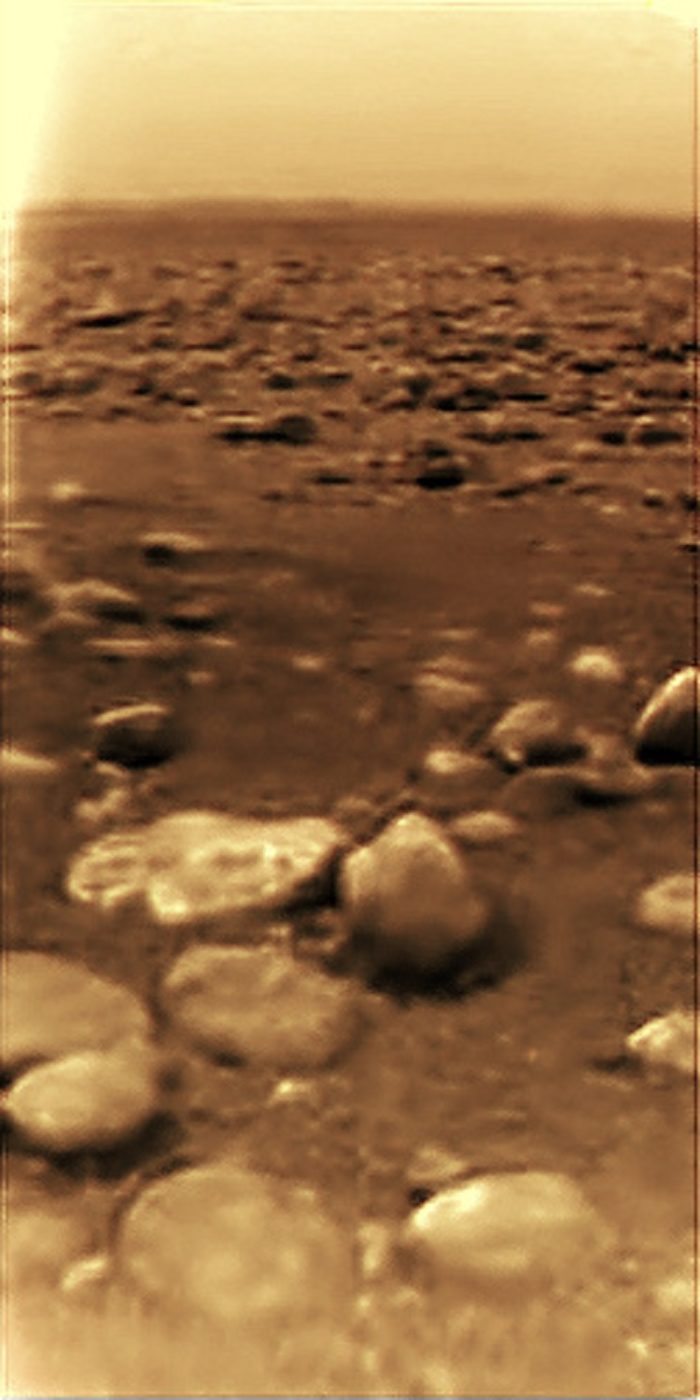
A close-up image of the surface of Titan
While most of us can take or leave pictures of the Moon, for example, with little fascination or wonder, likewise of Mars, to see a picture of the surface of a cosmic body as far out into the reaches of space is something much more mind-blowing. Among other things, the probe captured a dark-colored surface with rocks scattered around, thought to be made of ice (water), while the sky appears a dull yellow.
Following the success of the Huygens landing, the Dragonfly mission is set to depart for the region in 2026. It will head into the atmosphere of Titan in order to collect data for the progression of prebiotic chemistry.
The video below looks at the successful Huygens landing mission a little more.
Future Missions To Titan
It is perhaps worth staying with this most fascinating satellite of Saturn for a little longer, not least as there are future missions in the pipeline to send further landers there. And while there are no solid plans to send humans to Titan (at least not yet), it will remain a prime target as space technology advances, perhaps not least due to the fact that a successful landing mission has already taken place.
For example, a joint mission between NASA and the ESA would have seen a hot-air balloon float around Titan for around six months exploring and mapping out the surface, as well as collecting other valuable data from the atmosphere. And while the proposal is still very much on the table, NASA and the ESA look set to dedicate more time, funding, and resources to their planned Europa missions.
Another proposed mission was the Titan Mare Explorer (TiME) which was planned to land in the northern regions of the moon where a lake resides. It would then collect data while navigating the lake for several months.
As well as the scientific research that would undoubtedly take place, there would likely be significant opportunities for both space mining operations and space tourism. After all, the likely astronomical costs aside, who wouldn’t want to take a walk around Titan, or float over the surface in a specialized balloon with the majestic cosmic body of Saturn looking down at them?
The video below looks at Titan a little further.
The Outer Giants
Both Uranus and Neptune, the two gas giants in the outer reaches of our solar system also host moons of particular interest to scientists. And while reaching these intriguing worlds in the far reaches of the solar system may be out of the reach of our collective lifetimes (barring any sudden or rapid advancement in space technology), there is a small plethora of reasons to one day venture out as far as the smaller pair of the four gas giants.
Miranda – Another Location With Water Below The Surface
Miranda, for example, the smallest of Uranus’ moons, would be an ideal destination for a permanent base. [6] There are several extremely deep valleys and fault cliffs on Miranda which would offer ideal protection from the elements, which has no atmosphere to slow them down in any way. Given that radioactive particles from Uranus bombard Miranda, exposure to these for extended periods would be quickly lethal.
Initial studies suggest liquid water exists on the moon, which again would suggest geological activity. It also suggests a heat source within the cosmic body, as it is much too far from the Sun to keep water in liquid form. Miranda also has extremely low gravity, which means despite the huge drops from the erratic cliff faults, it would literally take minutes to land such would be the slow descent. It would further mean any injuries from such falls would be minimal.
The short video below looks a little further at Miranda.
Titania – An Unlikely Location For Landing!
Although there is perhaps little chance of any exploration in the imminent future, one of Uranus’ other moon, Titania, is of relative interest to scientists. Not least as the presence of liquid water near the core of the moon remains a possibility. We should note, however, what we know of Titania is limited, and the result of the flyby mission by Voyager 2 as part of its main mission to Uranus in January 1986.
What’s more, because Uranus is on its side resulting in it and its moons experiencing 42 years of sunlight followed by 42 years of night, only one half of Titania was visible to the probe. There are future flyby missions planned which will undoubtedly reveal more information.
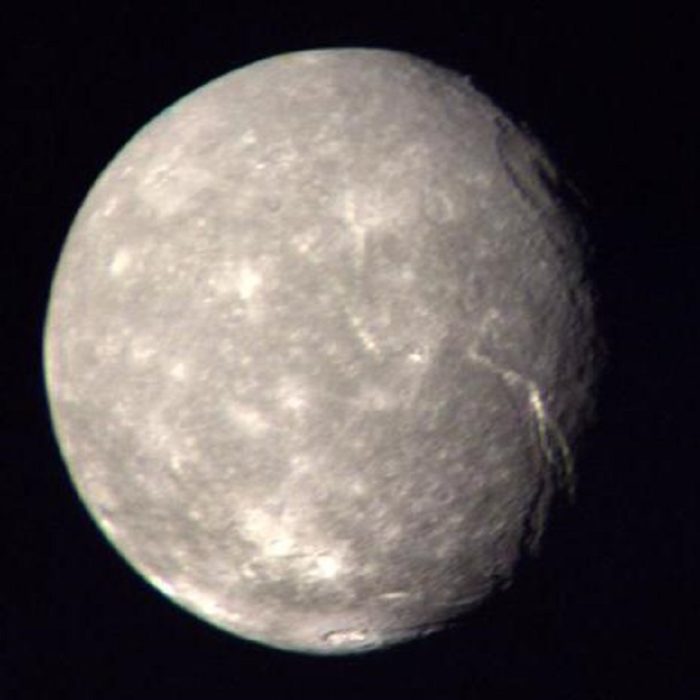
A close-up image of Titania
It is highly unlikely – if we assume the necessary technology existed – that a landing mission to Titania would take place. Like Miranda, the surface offers many deep canyons and craters. And some of these canyons and craters run for hundreds of miles. And while they might, in theory, offer some form of protection against the environment of space, there is plenty of tectonic activity to contend with.
If a basecamp was managed to be established on Titania, Uranus would be constantly visible to those on the surface. And what’s more, it would appear around 20 times the size that our moon appears to us. Furthermore, the freezing conditions and lack of atmosphere will require specialized suits to navigate the surface.
Triton – Perhaps The Strangest Moon In The Solar System
One of Neptune’s main moons, Triton, while offering a harsh environment, also has plenty of anomalies that warrant further study. For example, Triton rotates around its host in the opposite direction to the planet – something that no other moon in our solar system does. Part of Triton’s surface also reflects light to such an extent that it appears there is a “smooth, hard surface” which, while most likely ice, reflects as though it is metal.
There are also questions as to how Triton began its life with Neptune in the first place, given it is too large to simply have fallen into its current orbit, and is substantially younger than its host. Much like the moons of Uranus that we examined, the only probe from Earth to perform a flyby mission of Triton was Voyager 2, which did so in 1989.
What is not known is whether an ocean exists below the thick, icy crust of the planet’s surface. This alone makes it an intriguing destination for scientists. Several missions have been proposed for specific landing missions to Triton, however, none have progressed from the proposal stage (this is mainly due to the increased focus on the moons of Jupiter and Saturn, which are both significantly closer to Earth.
One intriguing proposal, though, was to send a lander to the moon of Neptune (called the Triton Hopper) which would then extract nitrogen ice from the surface. It would then use this as a propellent to navigate the surface, collecting data as it did so. Although the proposal is currently shelved, it is intriguing to see the notion of “space mining” being incorporated into proposed landing missions.
The short video looks a little further at Triton.
Much To Explore Closer To Home?
Of course, before we colonize the moons in outer space, a permanent base on our moon would have to exist. This is both for logistical reasons and as launch points for future missions. And if reports are true, these bases may be up and running a lot sooner than we think.
The Chinese Space Agency are making their attempts and desires known of establishing a base on the moon. And what’s more, they plan this within the next decade. Elon Musk is another person with very real desires to achieve such a feat. NASA would not sit idly by while private companies “claimed” the moon for themselves. Perhaps the persistent rumors of NASA’s own plans for a base on the moon will prove to be of substance.
If bases did exist on the moons of the solar system, traveling among the stars becomes a little more realistic. These would serve as “outposts” and “stop-off points” from one destination to another. In terms of recreational travel, propulsion would have to develop to a point so as to shorten traveling time considerably. Maybe taking a cruise around Jupiter and Saturn while stopping off for short stays on their icy moons may be a reality sooner than we might think.
Check out the videos below. It looks at ten of the most intriguing moons of the solar system that humans might one day colonize.
References
| ↑1 | Charon: The Mega-Moon With a Mountain in a Moat, Nadia Drake, National Geographic, July 16th, 2015 https://www.nationalgeographic.com/science/article/charon-moon-mountain-moat |
|---|---|
| ↑2 | Ganymede: Facts About Jupiter’s Largest Moon, Ken Zimmerman, Space, June 15th, 2016 https://www.space.com/16440-ganymede-facts-about-jupiters-largest-moon.html |
| ↑3 | Could We Live On Saturn’s Death Star?, Lulu Chang, Bustle, October 17thy, 2014 https://www.bustle.com/articles/44663-saturns-death-star-moon-might-be-suitable-for-life-thanks-to-its-giant-underground-ocean |
| ↑4 | What It Would Be Like to Live on Saturn’s Moons Titan and Enceladus, Joseph Castro, Space, March 10th, 2015 https://www.space.com/28786-living-on-saturn-moons-titan-enceladus.html |
| ↑5 | How Humans Could Live on Saturn’s Moon Titan (Infographic), Karl Tate, Space, March 12th, 2015 https://www.space.com/28788-living-on-titan-saturn-explained-infographic.html |
| ↑6 | What It Would Be Like to Live on Uranus’ Moons Titania and Miranda, Joseph Castro, Space, March 17th, 2005 https://www.space.com/28827-living-on-uranus-moons-titania-miranda.html |
Fact Checking/Disclaimer
The stories, accounts, and discussions in this article may go against currently accepted science and common beliefs. The details included in the article are based on the reports, accounts and documentation available as provided by witnesses and publications - sources/references are published above.
We do not aim to prove nor disprove any of the theories, cases, or reports. You should read this article with an open mind and come to a conclusion yourself. Our motto always is, "you make up your own mind". Read more about how we fact-check content here.
Copyright & Republishing Policy
The entire article and the contents within are published by, wholly-owned and copyright of UFO Insight. The author does not own the rights to this content.
You may republish short quotes from this article with a reference back to the original UFO Insight article here as the source. You may not republish the article in its entirety.

